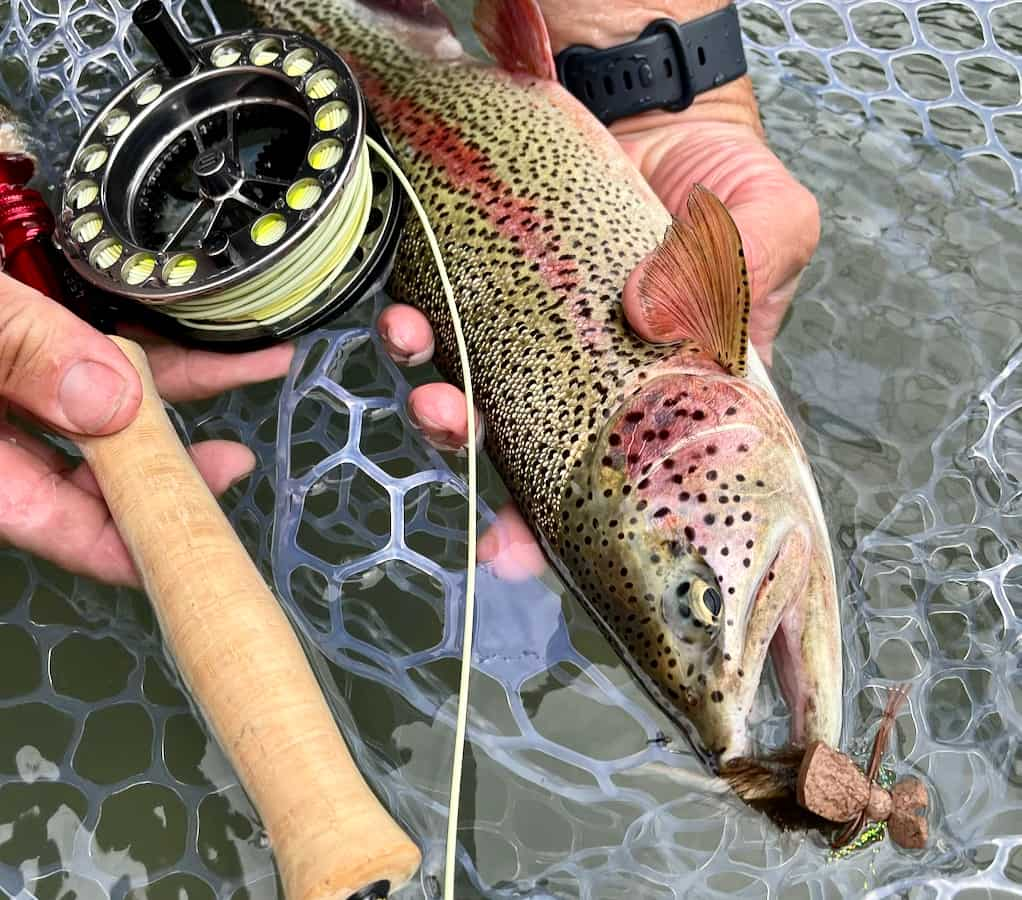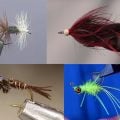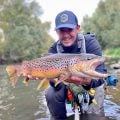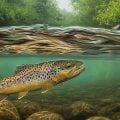Here Comes the Boom: How to Fish with Mouse Flies

Image by Dave Holsman
I’ve always been a big fan of the Discovery Channel. Growing up, I’d sit on the couch with my eyes glued to the screen, on the edge of my seat with anticipation. The programming was always beautiful and informative, but the real reason I was so obsessed with such nature shows were the predators. A lion charging out of the brush and pouncing on the zebra, a crocodile popping up and grabbing wildebeest, or best of all, a shark hurling itself from the water with a seal clamped in its mouth—those were my favorite parts. I know that sounds slightly, uh, “serial killerish,” but as I have repeatedly told my therapist, my fascination had nothing to do with the blood and guts of it all, but rather with the act of predation. The ambush, the attack—frankly, it was all just so cool.
Fast forward a few years to me standing on the banks of a river at sunset, tying a mouse fly onto my line and watching a big brown trout feed along the edges of the willows. I made a long cast ahead of him, landing the mouse just off the bank. Then I pulled it off with a few quick strips, and saw the brown turn and absolutely explode on the fly. It was awesome, it was fantastic—it was just like being a kid again. I’ve been obsessed with mousing ever since.
Predatory Joys
Mousing is perhaps the most thrilling way to catch trout in all of fly fishing. As fly anglers, we often become so focused on matching the hatch and concentrating on that one faultless presentation to rising trout that demands complete drifting perfection, that we forget that trout are predators. They are the lions and tigers of the river, and often enough, they’ll aggressively devour anything they can fit in their mouths, especially if it’s struggling on the surface of the water. Mousing is a way of fishing that capitalizes on this aggression. It acts on a trout’s predatory instincts and their ability to take the opportunities that are given to them.
When you splash down a mouse fly and rip it across the water, strikes are often unexpected and volatile. They come from seemingly nowhere in an act of such pure ferocity that it can make you reconsider a dislike for death metal music. But mousing can also be a fickle mistress and it isn’t always the most productive fishing method. I’ve spent many a fishless day chucking a mouse on some awesome looking water only to come up empty. Yet when it’s good, mousing is like base jumping, holding your breath in constant anticipation, wondering whether your parachute is going to open. Except that when it does come together, the excitement only continues to build.
When to Use Mouse Flies
You can catch fish on a mouse in the early morning, the middle of the day, or in the early evening, but there’s no doubt that the best time to go out mousing is at night. Just like so many other predators, truly big, mouse-gobbling trout are nocturnal, only coming out of their dark holes in the river when the last rays of the sunset are vanishing from the sky. This makes the last light of the evening an ideal time for discovering what sort of trout may be going bump in the night in your favorite waters.
Night fishing with mice is its own challenge. In the dark of the river, when all you can see is blackness, the fishing becomes almost surreal. As if you were fishing blind, it plays to your sense of hearing and to your sense of touch, so much more than in the visual comfort of daylight. You’re listening for the splash of your fly hitting the water and you’re feeling the pull of water on the line to know your fly is swimming right. All the time hoping for the sound of an explosive splash and the screaming drag of a strike.
It’s an unworldly experience. Being out in the foreboding stillness of the evening with only moonlight for company, with the darkness playing on that ancient fear left in behind in your subconscious when being caught out in the night meant you were prey. You cast into the blackness, hold your nerve, and wait for the sound of a strike from the abyss. It’s just a thrill that no other form of fly fishing can replicate.
How to Fish a Mouse
There are only two ways to fish a mouse—stripping and swinging. Both techniques can be equally effective at producing smashing, line-screaming strikes in the dark, so long as you’re doing them in the right areas of the river. However, to make sure you’re getting into as many topwater trout as possible, you have to make sure you are using the right type of fly pattern for your chosen technique.
Mouse patterns come in a variety of sizes, shapes, and colors. Some are simply a piece of slim foam meant to create a wake on the water, while others are true to life artistic creations that look like something you’d find in a cheese-baited trap or dancing and singing on the Disney channel. For stripping, your best bet is the latter, with the garish and more realistic patterns creating more commotion in the water. However, as cool as it is to see a trout explode on a fly the size of a rat, you’ll probably have better luck on slightly smaller, slimmer profiled patterns such as the Master Splinter and the Minnie McMouse Face. For swinging, you’re going to want a low-profile pattern designed for skating and waking on top of the water such as the Waking Mouse or Moorish Mouse.
Casting and stripping mice is best done in faster water and areas of the river with a lot of structure. Target the edges of the bank, log jams, boulders, rapids and along any spots with a sharp drop off into deeper water. These are perfect places for big, night-hunting trout to be holding, waiting to pounce. Splash your fly down hard in these spots and then strip them back rhythmically, adding a few jerks and pauses with your rod tip. Usually that’s all it will take to trigger an explosive strike.
Swinging mouse flies usually works best in longer, slow moving pools where a lot of splashy and frantic action would otherwise startle the fish. It’s also a great way to cover water on big rivers without a lot of obvious structure. Ideally, you’ll swing through currents that are flowing at about a walking pace. Cast your mouse down and across the stream at roughly a 45-degree angle and then swing it across the current as the line comes tight so that the mouse is leaving a slight V-shaped wake behind it as it moves. If this isn’t producing, you can also raise the rod and begin adding in small flicks with your rod tip as the fly drifts that cause it to dash and dart along the water as it swings. Keep your line tight when you do this, though, as strikes can be sudden and violent enough to rip the rod right out of your hands.
Worth the Squeeze
When It really comes down to it, mousing is a hit or miss game that can be the most thrilling or most boring time you have ever spent on the water. Yet for those who like to break away from the ordinary, hum-drum of every day fly angling, it can be the experience of a lifetime. That first time you’re successful and that big trout comes rocketing out of the water like a moon-lit, aquatic cruise missile and smokes your fly, it can leave you breathless, shaking, and realizing that mousing is way better than anything you’ve ever seen on TV.











